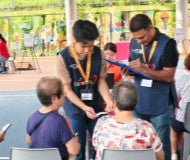Singapore General Hospital will NEVER ask you to transfer money over a call. If in doubt, call the 24/7 ScamShield helpline at 1799, or visit the ScamShield website at www.scamshield.gov.sg.
Help Us Improve Your Experience:
We’d love to hear from you! Rate the SGH website and share your feedback so we can enhance your online experience and serve you better. Click here to rate us
Non-English translations are machine-generated; verify independently for
potential
inaccuracies.
Let us help you find what you're looking for.
Paediatric Hearing Aid Services
Synonym(s):
Centre for Hearing and Ear Implants
- Centre for Hearing and Ear Implants
- ENT Specialist Consultations
- Universal Newborn Hearing Screening
- Adult Diagnostic Audiological Services
- Adult Hearing Aid Services
- Paediatric Diagnostic Audiological Services
- Paediatric Hearing Aid Services
- Cochlear Implants
- Bone Conduction Hearing Devices
- Middle Ear Implants
- Auditory Verbal Therapy
- Listen & Talk Programme
- Professional Training & Education
For children diagnosed with hearing loss, early intervention through fitting of hearing devices is crucial to provide the child with good access to sounds during the critical period of speech and language development, which typically occurs during the first two years of life.
The Centre for Hearing and Ear Implants at SGH offers various types of hearing technology for children, including hearing aids.
Hearing aids are electronic devices that amplify sounds so that they become louder and clearer. They are recommended for children with hearing loss in one or both ears. Hearing aids come in different shapes and sizes, but generally fall within two categories: in-the-ear (ITE) or behind-the-ear (BTE) styles. For children, BTEs are recommended because the earmoulds can be replaced as they grow older.
Today, hearing aids often come in a wide assortment of colourful designs to cater to the paediatric population.

Credits: Phonak
FAQ For Parents
1. Why do audiograms obtained at different centres vary?
Calibration of audiological equipment and soundfield rooms ensures that testing levels meet required international standards. As such, results of hearing tests obtained should be similar in all centres, and if the child responds reliably, a 5-10dB variability is acceptable.
All our equipment have been calibrated and will be recalibrated every six months to ensure that our test conditions meet with international standards. Recalibration showed the initial calibrations were correct. We are confident that our testing levels have been/are correct and will continue with weekly biological calibrations to ensure test reliability.
In some previous audiograms obtained at other centres, no masking of the better ear has been used when testing the worse ear. When there is more than 40 dB difference between ears at any frequency, a narrow band noise needs to be used to mask out the good ear when testing the worse ear. Masking ensures responses are only coming from the worse ear. If masking is not used we might think the worse ear has more hearing than it really does due to cross hearing.
Audiologists need to be mindful of false responses, which is when a child responds in time with a stimulus but has not heard the sound. Children can fall into a pattern of responding, and so it is very important to vary the stimulus interval time and use non-stimulus trials often during the testing session.
2. What is the recommended volume for my child’s hearing aids?
In SGH we have chosen to use the Desired Sensation Level (DSL) hearing aid fitting prescription method primarily because it is the only current method specifically designed for use with children. Other popular fitting methods were designed for adults with an acquired hearing loss and adapted for use with a paediatric population.
The DSL rule prescribes more gain than other fitting rules particularly at 2000 Hz. Research has shown that 2000 Hz is the key frequency for intelligibility of speech. In order to give a child access to the softer high frequency components of speech, the volume may need to be tuned higher to match the DSL targets. The volume control and internal settings will be verified with an aided audiogram and/or aided speech discrimination test for each ear.
We do not recommend that aids be worn on full volume due to distortion that may occur. If aided testing indicates that the child does not have adequate access to the speech range with current aids appropriately adjusted, more powerful aids need to be considered. If no significant benefit is observed during a trial of the most optimal aid fitting, a cochlear implant would be the next consideration.
3. Why do the aids sound so loud and will this damage my child's hearing?
As most parents have normal hearing sensitivity, the aids will sound loud, particularly if your child has a severe or profound loss. However, speech should still sound clear on the user volume. It is recommended that parents do listening checks daily to ensure the aids are working properly and that the clarity of the sound is acceptable.
Another advantage of the DSL paediatric fitting method is that uncomfortable loudness level and maximum power output targets are generated from the measured hearing levels. This means that we are able to predict with accuracy the level at which a sound becomes uncomfortably loud for a particular child based on his or her audiogram.
The aid can then be set so that loud sounds do not exceed these levels. Care is then taken to observe for any adverse reactions such as startling eye blinking, crying, or attempts to remove the aid in the presence of loud sounds. Such evaluations will be done in the clinic.
However, parents are always asked to watch out for and report any such behaviors in daily use. The maximum output levels can then be reduced accordingly, to ensure the child's comfort when wearing aids in noisy situations and most importantly, that the child's residual hearing remains intact.
The aid can then be set so that loud sounds do not exceed these levels. Care is then taken to observe for any adverse reactions such as startling eye blinking, crying, or attempts to remove the aid in the presence of loud sounds. Such evaluations will be done in the clinic.
However, parents are always asked to watch out for and report any such behaviors in daily use. The maximum output levels can then be reduced accordingly, to ensure the child's comfort when wearing aids in noisy situations and most importantly, that the child's residual hearing remains intact.
4. What causes feedback?
We are all familiar with the shrieking feedback which occurs when a microphone is held too close to a speaker. Feedback is caused by amplified sound being 'fed back' into the microphone of the hearing aid. Causes of feedback include damage to the ear mould, the tubing, the earhook or the hearing aid itself.
However, the most common cause is a poorly fitted ear mould. If the mould does not seal well in the ear, the amplified sound will leak out of the ear canal back into the microphone and cause whistling or feedback.
The more powerful the hearing aid and the higher the recommended volume, the greater the risk of feedback will be. And there is a greater need for a properly fitted mould.
However, the most common cause is a poorly fitted ear mould. If the mould does not seal well in the ear, the amplified sound will leak out of the ear canal back into the microphone and cause whistling or feedback.
The more powerful the hearing aid and the higher the recommended volume, the greater the risk of feedback will be. And there is a greater need for a properly fitted mould.
You can perform a simple test to isolate the cause of feedback:
- Turn the aid on. Most aids will whistle.
- Block the sound bore. The aid should stop whistling. If the aid stops whistling, the cause of the feedback is a poorly fitting ear mould. - Have new moulds made.
- If the aid does not stop whistling with the sound bore blocked check for damage to the ear mould, tubing, earhook or aid itself. - Take the aid in for repair.
5. How do I know when my child needs new ear moulds?
As young children grow, the shape of their ear changes. This means that new moulds will be needed approximately once every three months. However, many children need a change of new moulds more often.
In very hot and humid climates, such as Singapore, mould materials may shrink quickly and harden easily, which means new moulds need to be made often.
In very hot and humid climates, such as Singapore, mould materials may shrink quickly and harden easily, which means new moulds need to be made often.
Your child will need new ear moulds if:
a) feedback is occurring on the recommended volume setting
b) the mould appears loose in the ear
c) the mould material is becoming hardened or discolored
d) the mould or its tubing has been damaged
It is recommended that parents monitor the fit of the mold closely and try to order new moulds as soon as the old ear moulds begin to appear hard or loose. Do not wait for feedback to occur as sometimes it may take new moulds up to 2 weeks to be ready.
It is usually a good idea to have both new moulds made at the same time to avoid several trips to the hearing centre.
It is usually a good idea to have both new moulds made at the same time to avoid several trips to the hearing centre.
It is not uncommon for new moulds to give feedback due to problems with the ear impression taken or during the mould-making process. If the child cannot wear the new moulds on the recommended volume without feedback at the fitting appointment, ask for new impressions to be taken immediately.
Decreasing the volume to reduce feedback is not a solution as the child will not hear optimally on a lower volume setting.
Decreasing the volume to reduce feedback is not a solution as the child will not hear optimally on a lower volume setting.
Children's moulds should be made of a soft flexible material such as soft silicone to ensure a good seal in the ear and less risk of injury during play. Check that the new moulds seal tightly in the ear but do not cause soreness.
6. If my child has only mild hearing loss does he need to wear a hearing aid?
YES! Any hearing-impaired child with a hearing loss greater than 40dBHL in the better ear should be fitted with a hearing aid as soon as a reliable measure of the hearing sensitivity is obtained. Studies show that even minimal hearing loss can have significant impacts on speech and language development, attention behavior, learning capacity and social development.
7. What is the earliest age a child can be fitted with a hearing aid?
A child’s hearing sensitivity can be assessed as early as the first day of life using objective diagnostic tools such as otoacoustic emissions (this test measures an echo from the cochlear, which tells us how well the inner ear is working), ABR (auditory brainstem response test) and SSEP (steady state evoked potential test), which indicates frequency specific hearing levels in each ear. Therefore, a child as young as a few weeks old can be fitted with hearing aids.
8. Does my child need a FM system and what advantages do FM systems offer over hearing aids or cochlear implants alone?
Hearing aids and cochlear implants function best in ideal listening conditions, such as in a quiet situation with the speaker in close proximity to the hearing impaired child. We have all experienced difficulty in hearing when there is noise in the background, so likewise, it is difficult for a child to listen and learn in a noisy classroom.
A child with hearing sensitivity within the normal range requires speech to be 2 times louder than the background noise to understand a speech signal. However, a hearing impaired child needs a speech signal 10 times louder than the background noise to comprehend the speaker. The most effective means to improve the signal to noise ratio is by the use of the FM system. The speaker wears a remote microphone and transmitter while the child wears a receiver.
The receiver connects to the hearing aids and receives direct audio input from the speaker's microphone. As the speaker's microphone is positioned close to the mouth (10 cm is ideal), the child hears the speaker as if he is very close by, regardless of the distance between them. This gives mobility to a teacher in a classroom and assists the teacher greatly in gaining the child's attention from a distance.
The receiver connects to the hearing aids and receives direct audio input from the speaker's microphone. As the speaker's microphone is positioned close to the mouth (10 cm is ideal), the child hears the speaker as if he is very close by, regardless of the distance between them. This gives mobility to a teacher in a classroom and assists the teacher greatly in gaining the child's attention from a distance.
When using the FM system, both the speaker's microphone and the child's hearing aid microphone should always be active. The FM microphone is given priority over the hearing aid microphone when the speaker is talking. However, the child is still able to monitor his own voice and those of his classmates around him using his hearing aid microphone.
The Ministry of Education provides the FM system free for all hearing impaired children attending primary schools. Please ask your audiologist for the FM system request letter and you should submit the letter when registering your child in a primary school. Your therapist can give you further advice.
Stay Healthy With
Singapore General Hospital,
Outram Road, Singapore 169608
Outram Road, Singapore 169608
© 2025 SingHealth Group. All Rights Reserved.



















